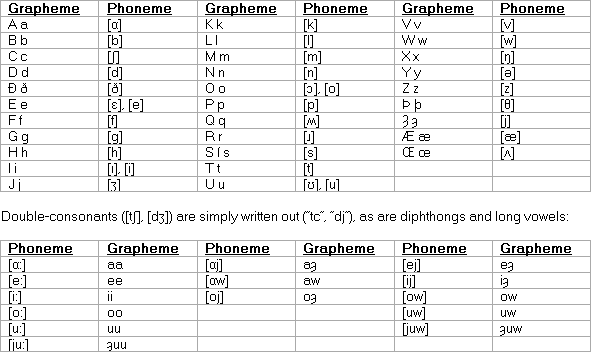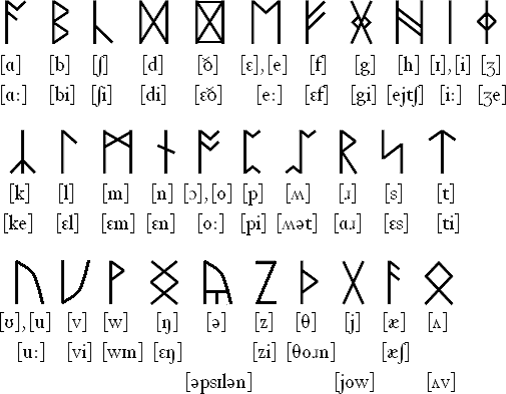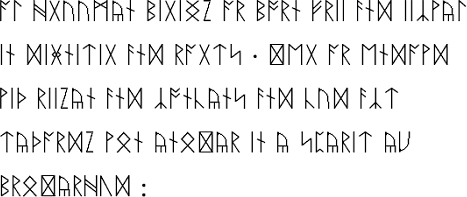A phonetic alphabet created by John D. Higgins
This alphabet began with an attempt to create a phonetic system using only Latin, Old English, and Middle English letters. Every letter from all the past incarnations of English, except the runic letter wynn, was represented in this system.
The "alpha version" of the "Modern English Phonetic Alphabet" looked like this:

Obviously, the dialect of the writer can result in a considerable degree of spelling variation, particularly where vowels are concerned.
Regarding the choice of which values to assign which letters, some (such as thorn and eth representing the interdental fricatives, and using ash for short a), were obvious, as those are the sounds they stood for in Old English. Yogh likewise very often stood for the palatal approximate in Middle English. Using c and j for the post-alveolar fricatives was also kind of obvious, given their close relation to palatal affricates. That only left the problem of where to assign the mid unrounded central vowel (short u), the voiceless bilabial approximant (wh), the velar nasal (ng), and the schwa. The remaining letters were q, x, y, and œ (wynn having already been consciously left off the list, since it looks too much like p).
Y, given the frequency that it shows up in place of other vowels (especially in Middle English), meant that it wouldn't be too jarring to see that letter used for the schwa. That left œ for the short u sound, not much of a stretch given that this symbol represents a similar-sounding (but rounded) vowel in French (the same vowel written by umlat o in several Germanic Languages).
Using q for the voiceless bilabial approximate isn't all that far-fetched either-the /kw/ sound we're so used to seeing "qu" represent, after all, is an Indo-European sound that became /ʍ/ in the Germanic languages due to Grimm's Law. That's why all the interrogative pronouns that start with "wh" or "hw" in Germanic languages begin with a "qu" in Italic languages.
That only left x to represent /ŋ/, which may be kind of arbitrary, but no more so than the Romans taking the Greeks' voiceless aspirated velar plosive and making it a /ks/ double consonant.
It was at this point, upon finally arriving at a workable phonetic writing system, that it was decided that runes would simply look better than Latin letters. Now, as great as the standard Anglo-Saxon fuþorc is for writing Anglo-Saxon, it's not quite up to snuff for writing Modern English. There are too many vowels (mainly diphthongs, like io, eo, and ea, that have long since collapsed into simple vowels in ModE) and not enough consonants (a single symbol in the OE fuþorc serves for each of the labiodental, dental, and alveolar fricatives-there are runes for f, s, and þ, but not for v, z, and ð).
In order to make up for this, the excess vowel runes (geoh, ior, and ear) as well as the redundant double-consonants (eolx, kealk, and stan) have been dropped. In their place, to make up for the deficiency in single voiced consonants, this alphabet does with the Anglo-Saxons themselves once did with the letters thorn, wynn, and ash-that is to say, shamelessly borrow glyphs from an alphabet that does have them. Thorn and wynn were just plucked from the fuþorc and dropped into the alphabet; there's little reason not to do the same with v and z. Ash, while it retained its Runic name, was basically just constructed from Latin letters to represent a non-Latin sound. It's not hard to do the same thing to the d-rune (dæg) to make an eth-rune (in fact, just as the Irish created the letter eth by adding a stroke to an uncial d, here an eth rune has been made by adding two strokes to the dæg rune).
Thus, we have the "beta version", the Modern English Runic Alphabet:

Shown above are the glyphs, the phonemes they stand for below each symbol, and each symbol's assigned name below that.

Al hȝuumyn biȝixz ar born frii ænd iikwyl in dignitiȝ ænd raȝts. Ðeȝ ar endawd wiþ riizyn ænd koncyns ænd cud ækt tywardz wœn ynœðyr in y spyrit yv brœðyrhud.
All human beings are born free and equal in dignity and rights. They are endowed with reason and conscience and should act towards one another in a spirit of brotherhood.
(Article 1 of the Universal Declaration of Human Rights)
If you have any questions about Modern English Runic, you can contact John at: jack_daniel_327@yahoo.com
Another adapatation of Runes (Younger Futhorc) for English
https://anglish.miraheze.org/wiki/Younger_Futhorc
Constructed scripts for: Ainu | Arabic | Chinese languages | Dutch | English | Hawaiian | Hungarian | Japanese | Korean | Lingala | Malay & Indonesian | Persian | Tagalog / Filipino | Russian | Sanskrit | Spanish | Taino | Turkish | Vietnamese | Welsh | Other natural languages | Colour-based scripts | Tactile scripts | Phonetic/universal scripts | Constructed scripts for constructed languages | Adaptations of existing alphabets | Fictional alphabets | Magical alphabets | A-Z index | How to submit a constructed script
[top]
Why not share this page:

If you like this site and find it useful, you can support it by making a donation via PayPal or Patreon, or by contributing in other ways. Omniglot is how I make my living.
Note: all links on this site to Amazon.com, Amazon.co.uk
and Amazon.fr
are affiliate links. This means I earn a commission if you click on any of them and buy something. So by clicking on these links you can help to support this site.
Get a 30-day Free Trial of Amazon Prime (UK)
If you're looking for home or car insurance in the UK, why not try Policy Expert?
[top]